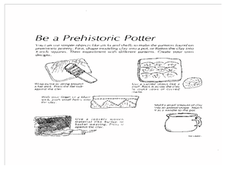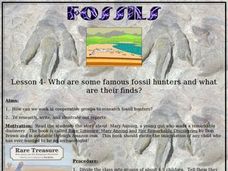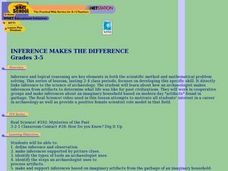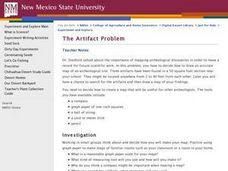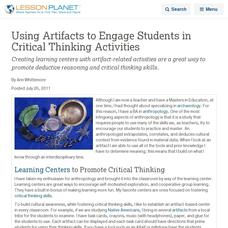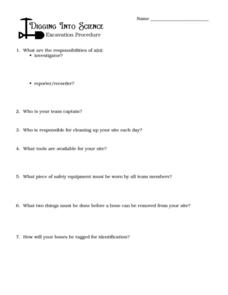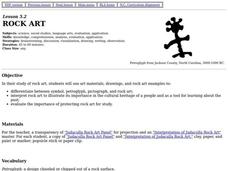Curated OER
Dr. Dirt's Archaeology Lab Artifact Analysis
Learners simulate analyzing artifacts in archaeological lab by using real techniques that archaeologists use. Students practice measuring skills, drawing, writing, and brainstorming, and make inferences based on evidence.
Curated OER
Archaeology
Students compare and contrast the role of scientists with that of archaeologists. They also describe the roles of observations and evidence in science.
Curated OER
Archaeology
In this archaeology worksheet, students answer 8 questions about archaeology. For example, "How are most archaeological sites discovered?"
Curated OER
Shoe Box Archaeology
Students assemble a shoe box following a layered pattern alternating between soil and artifacts. The layers of artifacts begin with the grandparents and end with the student's own personal possessions.
Curated OER
Shoe Box Archaeology
Students make a box layered with information about grandparents, parents, and themselves. They dig up each other boxes and try to decipher the personality or lifestyle of the person whose box it is.
American Museum of Natural History
Buried Bones
Patience is the name of the game. Using Plaster of Paris and chicken bones, learners simulate an archeological dig site. They excavate the chicken bones over a period of several days using tools and a large amount of patience.
Curated OER
Human Tools: From Stone to Iron
In this tools activity, students read about the tools used during the Stone Age and how the process of smelting lead to a great change in tool making. Then students complete 3 short answer questions.
Curated OER
Archaeology and Prehistoric Native Americans
Students study the terms paleontology and archaeology and examine how they can help us learn about prehistoric Native Iowans. In this archaeology lesson students discuss these terms and view a video on Native Americans.
Curated OER
Lesson Design Archaeology
Students participate in their own excavation and measure and record as they go. In this archaeology lesson students divide into groups and solve the mystery of what they uncovered in their dig box.
Curated OER
We Really Dig Archeology and Palentology
Sixth graders examine the differences between archeology and paleontology. Using the internet, they explore the tools and techniques used in each field. They must use the correct tools to uncover and record the objects they find. They...
Curated OER
You are the Archaeologist
Kids can practice their observation and evidence-based argument skills with a fun and engaging look at artifacts. With a given set of objects, each child will sketch and describe the object, then partners work together to determine...
Curated OER
Back From the Future
Young scholars pose as archaeologists, famous for their scholarly excavations, writing, and lectures about ancient cultures and are invited back to the 20thy century from the year 3000 to explore an archaeological sit, their classroom.
Curated OER
Fossils Lesson 4 - Who Are Some Famous Fossil Hunters and What Are Their Finds?
Learners research and develop a presentation about a famous fossil hunter/archaeologist. In this fossil hunter/archaeologist lesson plan, students listen to a reading of Don Brown's, Rare Treasure: Mary Anning and Her Remarkable...
Curated OER
Inference Makes the Difference
Students explore how archaeologists make inferences from artifacts to explore what life was like in the past. In this archaeology lesson, students work in groups and make inferences about an imaginary household based on modern day...
Curated OER
Dig It Up
Students participate in an archaeological excavation to determine how archeologists make inferences about various cultures. They reconstruct the site using layers of drawings. They discuss the kinds of information they learned.
Curated OER
The Artifact Problem
Students work in small groups and make a map of a familiar room. In this artifact lesson plan, students decide on a suitable scale for their maps, the tools they will use and how they will make it and decide on strategies they would use...
Curated OER
Using Artifacts to Engage Students in Critical Thinking Activities
Creating learning centers with artifact-related activities are a great way to promote deductive reasoning and critical thinking skills.
Curated OER
Let's Go To The Movies
Students explore technology used in making movies. In this movie making lesson, students investigate how technology has improved in the entertainment industry. Students discover how simple tools are combined together to make complex...
Curated OER
Hominid Diet
Students listen to an interview with Lucinda Backwell regarding fossil evidence that early hominids included termites in their diets. They participate in a discussion to investigate the significance of these findings.
Curated OER
Digging Into Science: Excavation Procedure
In this excavation procedure instructional activity, learners determine the roles of group members for an excavation of a sample box containing buried bones. They complete 9 short answer questions before beginning the excavation.
Curated OER
Stonehenge: Solving Ancient Mysteries
Students explore archeologists and anthropologists and the tools and methods they use to gather and interpret scientific evidence. They research current archaeological excavations and contact the scientists working at these digs.
Curated OER
A "Real" Picuture of a Scientist
Students share their own stereotypes when they talk about scientists. In groups, they draw a picture of a scientist where they are working and the tools they most commonly used. Using the internet, they discover how archeolgists use the...
Curated OER
Rock Art
Fourth graders examine and interpret rock art to illustrate its importance in the cultural heritage of a people and as a tool for learning about the past. They create their own rock art that is a symbol of their culture.
Curated OER
Cultural Murals
Seventh graders research the cultural time period of early Wisconsin people. They create a mural depicting the diet, shelter, activities, climate, clothing, tools, and other materials used.







